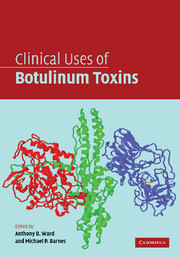Book contents
- Frontmatter
- Contents
- List of Contributors
- 1 Introduction
- 2 Mechanistic basis for the therapeutic effectiveness of botulinum toxin A on over-active cholinergic nerves
- 3 Botulinum toxin: from menace to medicine
- 4 Botulinum toxin: primary and secondary resistance
- 5 Introduction to botulinum toxin in clinical practice
- 6 Cervical dystonia
- 7 The use of botulinum toxin in otolaryngology
- 8 Spasticity
- 9 Hyperhidrosis
- 10 Hypersalivation
- 11 Botulinum toxin type A for the prophylactic treatment of primary headache disorders
- 12 Botulinum toxin in the management of back and neck pain
- 13 Clinical uses of botulinum toxin
- 14 Bladder and bowel indications
- 15 Cosmetic uses of botulinum toxin A
- 16 Other clinical neurological uses of botulinum toxin
- Index
- Plate section
- References
15 - Cosmetic uses of botulinum toxin A
Published online by Cambridge University Press: 02 December 2009
- Frontmatter
- Contents
- List of Contributors
- 1 Introduction
- 2 Mechanistic basis for the therapeutic effectiveness of botulinum toxin A on over-active cholinergic nerves
- 3 Botulinum toxin: from menace to medicine
- 4 Botulinum toxin: primary and secondary resistance
- 5 Introduction to botulinum toxin in clinical practice
- 6 Cervical dystonia
- 7 The use of botulinum toxin in otolaryngology
- 8 Spasticity
- 9 Hyperhidrosis
- 10 Hypersalivation
- 11 Botulinum toxin type A for the prophylactic treatment of primary headache disorders
- 12 Botulinum toxin in the management of back and neck pain
- 13 Clinical uses of botulinum toxin
- 14 Bladder and bowel indications
- 15 Cosmetic uses of botulinum toxin A
- 16 Other clinical neurological uses of botulinum toxin
- Index
- Plate section
- References
Summary
Introduction
The cosmetic uses of botulinum toxin (BoNT) are the most commonly used of its applications. Interest started after the effect of BoNT was shown in the treatment of blepharospasm and the first description of botulinum toxin for treatment of glabellar frown lines was in 1992. At that time, the use of this potent neurotoxin for cosmetic indications was an interesting footnote to treatments for strabismus, torticollis and other dystonias. Subsequently, physicians began to study and use the botulinum toxins for a variety of cosmetic indications. Today, BoNT is the most commonly performed cosmetic procedure in the world. Understanding how these toxins are used in this arena is essential to any discussion of the botulinum toxins.
Dilution of the toxin for cosmetic purposes
For the purposes of this chapter, the dilution of BoNT will be described in units of the BOTOX® brand of type A toxin. Oculoplastic specialists usually inject using a 1 ml dilution per 100 units of BOTOX®, whereas dermatologists and plastic surgeons vary in their practice towards a general range from 1 ml to 4 ml per 100 units. Variations in concentration affect the concentration gradient between the toxin and its environment. In the forehead, for instance, a dilute concentration may be preferable in order to increase migration, but, in general, clinicians use lower volumes to minimize the risk of this getting into unplanned areas.
- Type
- Chapter
- Information
- Clinical Uses of Botulinum Toxins , pp. 328 - 348Publisher: Cambridge University PressPrint publication year: 2007
References
- 2
- Cited by

